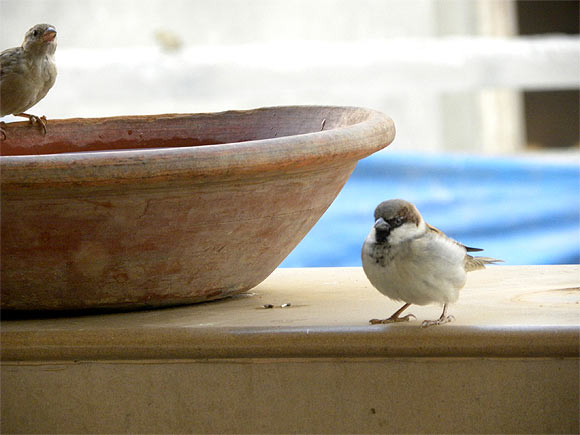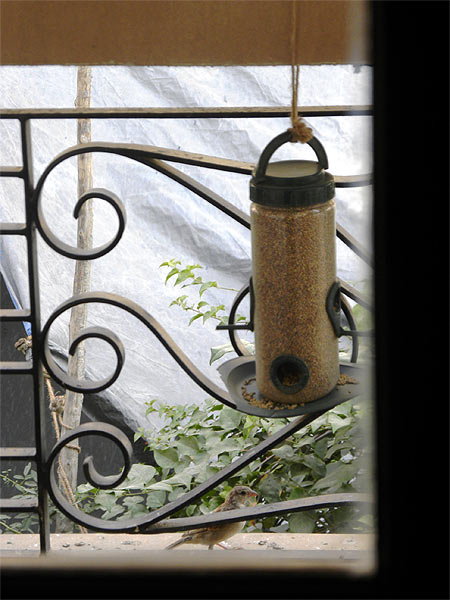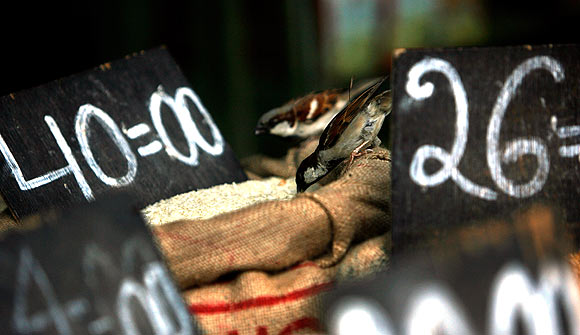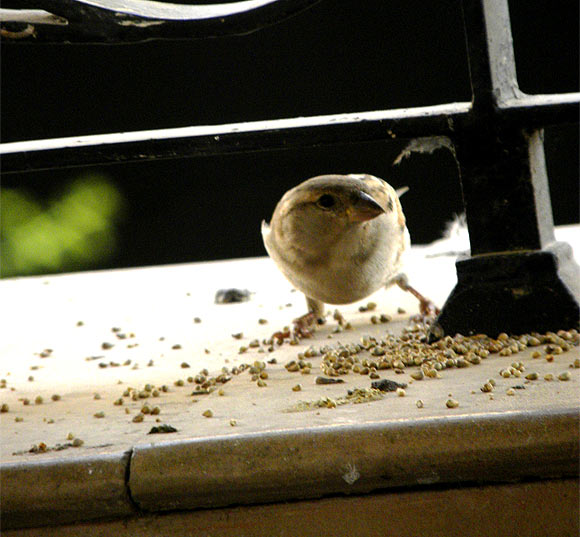 | « Back to article | Print this article |
'Today people don't like sparrows nesting in their homes'
When was the last time you noticed a sparrow in your window?
Why are sparrows endangered in India?
Vaihayasi Pande Daniel tells you how you can help prevent sparrows going extinct in India.
The tiger is going extinct in India.
So is the vulture.
The elephant.
And the Ganges river dolphin.
These are larger than life, magnificent creatures. Hearing their stories of extinction makes us sad.
But would your heart be as full to hear that the common house sparrow is also vanishing?
Yes, sparrows are slowly being wiped out as our malls and sleek apartment buildings come up in a 'Shining' India?
Sparrows are as important to our ecology system as tigers, as Chinese Communist dictator and sparrow mass murderer Mao Zedong foolishly found out and it is time we were worried.
A small organisation called the Nature Forever Society, headed by Mohammed Dilawar, and a band of sparrow adopters may be the only protection the frail, gentle sparrow has in India today.
Dilawar, who has done his master's in environmental science and ecology and has worked for the Bombay Natural History Society, became interested in birds early on. He set up the Nature Forever Society in 2009 and the society initiated the Common Bird Monitoring Programme (www.cbmi.in), an innovative project to monitor common birds. It was launched in Mumbai, India, March 2012 on World Sparrow Day.
The CBMI monitors, through detailed mapping, the 18 common bird species found across the country like the house crow, the rock pigeon, rose-ringed parakeets, Ashy Prinia (a wren-warbler) and the Hoopoe, in addition to the sparrow.
The success of Dilawar's project rests on the group of ardent birdwallahs he has invited onto his sparrow bandwagon, across the country -- you can be one too with not much effort -- to help revive the population of this tiny brown-grey bird, which weighs hardly 40 gm.
At 6 am I am on the metro to a home in Gurgaon. Dilawar has coordinated a meeting with one of his sparrow foster moms (bird adopters) who has 10 feeders in her home that she supplies with 50 kg of bird feed a month or more. She also has bird baths up and those magical nest boxes (Rs 309) that are the key to boosting populations.
Sparrows are shy, elusive creatures. They feed only in the morning hours and are then mostly invisible during the day, hence the necessity to view them before 8 am.
The Nature Forever Society's simple low cost (Rs 89) bird feeders are a hit around here.
Hundreds of sparrows flood the terrace and balconies of this home, twittering gleefully, hopping from feeder to bird bath, preening themselves and generally catching up with their mates.
It is actually a beautiful sight. Not intrusive like say a mob of pigeons.
When you look out from the terrace and homes and areas nearby you do discover that Sparrow Central is here and it is difficult to spy congregations of sparrows elsewhere, a clear demonstration of the success of NFS's efforts.the Nature Forever Society..
In this interview to Rediff.com, Dilawar explains how he got interested in sparrows and why sparrow conservation is essential
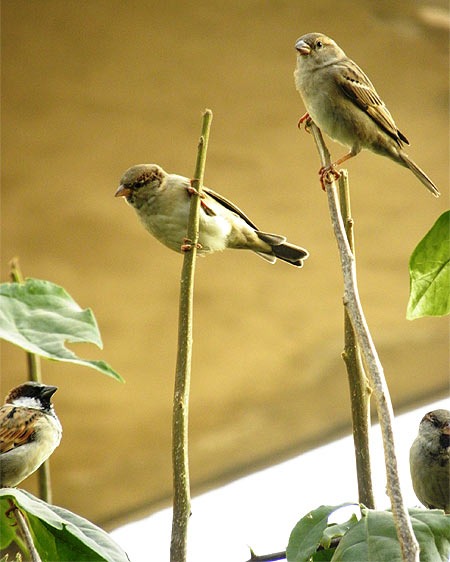 Why did you get interested in sparrows initially?
Why did you get interested in sparrows initially?
Right from childhood, sparrows have fascinated me immensely. During my childhood they were all over, in and around us. We had sparrows nesting everywhere in our home and in those days no one even minded them nesting inside the home.
They were a part of the family.
In fact, for the past 10,000 years sparrows have been companions to humans. They have evolved with us over a period of time and are an important and integral part of human-associated landscapes.
Eight years ago, when I came across a scientific article on the decline of house sparrows in the United Kingdom, I started investigating their status in India.
To my shock I came to know we have never counted our sparrows and other common birds and there are no conservation initiatives, or will, both in the scientific community as well as at the government agencies.
That was when I decided that I will work towards the conservation of house sparrows.
What did you family think of your obsession with sparrows?
All these years my family has been the biggest support in this entire journey today. Our whole family has gotten involved in some way or the other and without them a lot of this would not have been possible.
They believed in me when the whole world laughed and called me crazy, because I wanted to work on sparrows and not tigers.
Are sparrows your full-time job?
Yes, they are. In fact, there is so much to do for them, so much to learn about them, that I think one life is not enough.
The more I learn about them and the more we work for them, I realise how little we know about them.
For me, it's a lifelong passion as well as commitment. I often tell people that for me all birds are sparrows. In a way, my life revolves in and around the sparrows.
Why is the house sparrow getting rarer? What are the human developmental activities disturbing the house sparrow?
Human population is growing at a frantic pace. As a result, development is happening too fast, and in way which doesn't take issues like biodiversity conservation into consideration, when (the construction of) buildings, townships and development is undertaken.
The new buildings and landscaped gardens which are being constructed are not at all sparrow friendly. The modern glass-clad match box shape buildings do not have cavities which are important for sparrows to make nests.
We are also becoming increasingly intolerant as a species. For example, today people would not like sparrows nesting in their homes and dropping nesting material inside.
The lifestyle of people has also changed. Women no longer sit outside their homes to clean grain or offer grain or chapatti, which was a daily routine once upon a time and this was a source of food for sparrows.
As the habitat and food is shrinking, so are the numbers of house sparrows. Hence, we want people to take part in the creation of alternative habitats for house sparrows by adopting nest boxes and bird feeders.
Please click NEXT to read further...
'Today sparrows have become glamorous, so everyone wants to use it to be in the limelight'
Why is the sparrow important to our ecology?
The sparrows play an important role as insect controllers as they eat a phenomenal numbers of insects. They depend exclusively on an insect diet to feed their young ones.
Also as sparrows are abundant they act a food for birds of prey. If sparrows are not there, the population of birds of prey may also be affected.
Apart from this, every constituent of an ecosystem is important from an ant to an elephant. We are eliminating species by species which are important links which make the web of life.
Today it's these species which are getting extinct. Tomorrow, it will be us.
The sooner we understand this, the better it will be. We need to understand that we are part of the ecosystem and we are dependent upon other species for our survival and not the other way around.
They can live happily on the earth without humans, but humans cannot live without plants and animals.
The example below from China will summarise everything.
'Mao Zedong blamed rats, flies, mosquitoes and sparrows for the failure of the 1957 grain harvest.
Mao ordered the massacre of 1.96 billion sparrows between March and November 1958, despite the objection of experts that sparrows were in fact the major defence of the grain fields against insects.
The killing culminated on December 13, 1958, when Shanghai residents reportedly destroyed 194,432 sparrows.
Like the sparrow extermination order issued by a Prussian ruler in the late 18th century, Mao's sparrow-killing campaign had two serious consequences. First, insects destroyed more of the grain harvest than ever in 1959. Second, a generation of the Chinese youth internalised violence against the weak and defenceless as an acceptable behaviour in the name of serving the interest of "the people."
The policy-induced famine of 1960-1962 killed 40 million Chinese.'
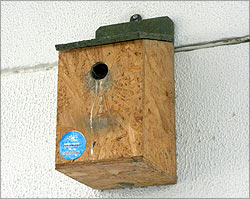 You have been working on this project for a number of years. What is the status now?
You have been working on this project for a number of years. What is the status now?
What are the fresh challenges you are looking at?
There has been a considerable change in the attitude of the scientific community and government agencies as far as the sparrows are concerned.
Recently we got the house sparrow declared as the state bird of Delhi, something which till recently was done only for glamorous birds.
The fresh challenges are now getting citizens involved in the monitoring of house sparrows and other common birds of India.
What has not changed, and which needs to be changed, is the attitude of the conservationist and citizens to work on common species.
Today sparrows have become glamorous, so everyone wants to use it to be in the limelight.
What I really want people to do is to make other species also glamorous. I want more Mohammed Dilawars to take up one species and work relentlessly to make it as popular as sparrows.
I want someone to come up to me and say I want to work for Ashy Prinia or the house lizard. This is when the real change will happen.
Else, it will be the same old story -- that only glamorous species like tigers get all the conservation attention and resources.
Changing this mentality is something which is the most important challenge for me.
Please click NEXT to read further...
'They get emotionally attached to the whole cause'
How did you get the funding for this project?
Till now we have not got any funding from any funding agency for our work. We raise our own funds.
For this we devised the Adopt Nest Box and Bird Feeder Scheme eight years back.
How did you achieve momentum for your campaign of getting people to adopt sparrows?
This has not happened overnight and it has taken us eight years. We have to start it afresh every single day.
We would not have made this possible without the support of our sparrow supporters who continue to support us and spread the word. The Indian media -- both print and electronic who have been the biggest supporters -- we consider them one of our most important supporters.

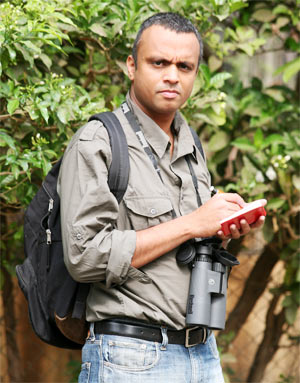 When people see sparrows breeding in the nest boxes they feel really happy about it.
When people see sparrows breeding in the nest boxes they feel really happy about it.
They get to see that this is how they are making a difference. They get emotionally attached to the whole cause.
For me, when an adopter calls us or sends us a photo of a nest box or bird feeder being adopted is the biggest award reward whatever you call it.
This is for which we work every single day of our life.
Also, the sparrow is a species about which the citizens of India are concerned the most as they have grown up with sparrows and have a very high level of attachment to them.
We work consistently to make them involved and engaged in the conservation of the house sparrow.
We make conservation exciting and do-able and not something which only scientists and government agencies can do.
This sense of taking the citizens along, and empowering them, is something which I think has really worked. A lot of organisations just see citizens as cash cows and only want them to donate money and not beyond that.
Please click NEXT to read further...
'I wanted conservation to be affordable to the citizens of India'
How did you hit on the belief that just a small wooden box would help the population of sparrows?
It must have been a challenge to get that feeder and box manufactured at the lowest cost. How did you surmount that challenge?
When I went to the UK for the first time I wanted to buy a bird feeder. But it was too expensive.
I then realised that if someone like me, for whom saving the sparrow is a life-long mission, is not able to afford it, how will my fellow country men support (the idea)?
I wanted to change how conservation was looked upon in India ie as something only the elite could afford. I wanted to make conservation affordable to the citizens of India.
But we have kept a very high level of standards in making our nest boxes and bird feeders. Quality is never something which is compromised. For this we have very strict quality control in place.
Please click NEXT to read further...
Finding ambassadors to Save the Sparrow
Tell us about the habits and the nature of a sparrow.
Sparrows need humans for their survival as the sparrow has evolved with us over the past 10,000 years.
Sparrows cannot survive without us.
As far as the ecological needs and habitats of sparrows are concerned they need human habitats for making their nest, food.
The sparrows breed four times a year in India and the young ones of the sparrows feed on an exclusively insect diet.
Today as our gardens are filled with exotic species of plants, sparrows are finding it increasingly difficult to feed their young ones.
This is one of the reasons why the mortality rates of baby sparrows is on the rise and a decline in population has taken place.
Are Indian sparrows different in any behavioural way from say a sparrow in London or New York?
As a species they are no different as far as ecological needs go. But, for example, due to the climatic conditions the sparrows in the UK do not breed as frequently as sparrows in India.
What does your work entail?
Our three main objectives.
To create a habitat for sparrows and other common birds: One of the main reasons for the decline of house sparrows is the lack of nesting sites and food.
So whenever anyone adopts nest boxes or bird feeders from us they are becoming sparrow conservationists and it helps in creating habitats for sparrows which is very important.
In this way they become important stake holders in the conservation of house sparrows.
We want people to become stake holders in conservation of house sparrows which is very important.
Getting emotionally attached to the cause: When you have a sparrow making a nest outside your home or when you have sparrows and other birds coming to feed every day from the feeder you become emotionally attached to the conservation of house sparrows.
You become the ambassadors of house sparrow conservation. This has helped in getting citizens involved in house sparrow conservation.
Fundraising: Whenever anyone adopts nest boxes and bird feeders the money helps us in running the organisation and doing functional conservation. It also gives us the freedom to do this which is important for the conservation of house sparrows.
Many of these things would not have been possible without the support of NFS sparrow supporters.
Please click NEXT to read further...
